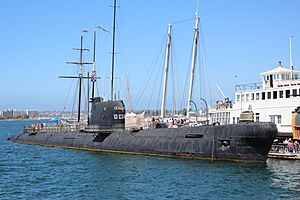Soviet submarine B-39 facts for kids

B-39, homeported in San Diego, California
|
|
Quick facts for kids History |
|
|---|---|
| Name | Б-39 |
| Builder | Admiralty Shipyard |
| Laid down | 9 February 1962 |
| Launched | 15 April 1967 |
| Commissioned | 28 December 1967 |
| Decommissioned | 1 April 1994 |
| Homeport | Vladivostok |
| Fate | Museum Ship, Maritime Museum of San Diego, San Diego, California, United States |
| General characteristics | |
| Class and type | Foxtrot-class submarine |
| Displacement |
|
| Length | 89.9 m (294 ft 11 in) |
| Beam | 7.4 m (24 ft 3 in) |
| Draft | 5.9 m (19 ft 4 in) |
| Propulsion |
|
| Speed |
|
| Range |
|
| Endurance | 3–5 days submerged |
| Test depth | 246–296 m (807–971 ft) |
| Complement | 12 officers, 10 warrants, 56 seamen |
| Armament |
|
B-39 was a Project 641 (Foxtrot-class) diesel-electric attack submarine of the Soviet Navy. The "B" (actually "Б") in her designation stands for большая (bolshaya, "large")—Foxtrots were the Soviet Navy's largest non-nuclear submarines. B-39 is now a museum ship on display at the Maritime Museum of San Diego, California, United States.
Service history
Her keel was laid down on 9 February 1962 at the Admiralty Shipyard in Leningrad (now known as Saint Petersburg). She was launched on 15 April 1967 and commissioned on 28 December 1967.
Transferred to the 9th Submarine Squadron of the Pacific Fleet, B-39 was homeported in Vladivostok. She conducted patrols and stalked U.S. warships throughout the North Pacific, along the coast of the United States and Canada, and ranging as far as the Indian Ocean and the Arctic Ocean. After the end of the Vietnam War, she often made port visits to Danang. During the early 1970s, B-39 trailed a Canadian frigate through Strait of Juan de Fuca to Vancouver Island.
In 1989, in the Sea of Japan while charging batteries on the surface, B-39 came within 500 yards (457 m) of an Oliver Hazard Perry-class frigate of the US Navy. Both crews took pictures of each other.
Post-USSR history
B-39 was decommissioned on 1 April 1994 and sold to Finland. She made her way from there through a series of sales to Vancouver Island in 1996 and to Seattle, Washington, in 2002 before arriving in San Diego, California, on 22 April 2005 and becoming an exhibit of the Maritime Museum of San Diego. During her sequence of owners she acquired the names "Black Widow" and "Cobra", neither of which she had during her commissioned career.
When B-39 was made a museum the shroud around her attack periscope was cut away where it passes through her control room. As built, a Foxtrot's periscopes are only accessible from her conning tower, which is off-limits in the museum. With the shroud cut away, tourists can look through the partially raised periscope (which is directed toward the USS Midway museum, some 500 yards (460 m) away). However, the unidentified and unexplained change gives the false impression that one periscope could be used from the control room.
At one point B-39 was slated to be sunk to create an offshore diving reef, but an outcry from teachers and enthusiasts have ensured the sub will stay put for the time being.
In 2000, while stored in Vancouver, B-39 was used as a stage for scenes in the Stargate SG-1 episode "Small Victories". In 2012 it was a stage for the movie Phantom.
Current Condition
B-39 is badly rusted with large holes visible in the outer hull and upper deck. While efforts are underway to keep her afloat for the time being, there are no plans to repair the extensive hull damage and it is expected she will have to be sunk at some time in the future.
Trivia
Due to the tight passages between compartments, guests are asked to climb through an obstacle before boarding the B-39. The obstacle can be found on the dock near the ramps leading to the submarine's deck. It resembles a large cylinder and represents the 4 doorways through the bulkheads.

